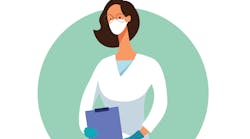Adventures in dental hygiene: How one wild temp day led this hygienist to some revelations
We’ve all been there, and all had our days, where everything goes wrong, or maybe everything goes right. But the stories we get to tell and the lessons we learn from these days are what allow us to grow as clinicians.
I had one of those days while temping. I arrived at an office on a Monday morning ready to get to work. The office seemed organized and on the ball. There was a list of daily and weekly tasks per position posted in central sterile, so I got straight to work. The first task was to replace the filters in the suction traps. While not a normal duty for a temp, I appreciated a good checklist, so I thought I’d play along. I donned my personal protective equipment (PPE)—heavy duty gloves, level 1 mask, eye protection, and my trusty Twice as Nice Uniforms lab coat—and got to work.
I replaced the filters in the hygiene rooms without incident, but when I got to the dentist’s operatory, I was in for a surprise. As I pulled the trap from the suction I was showered with bright red blood! It looked like a crime scene straight out of NCIS. I stood there stunned, not able to move for a second, unsure of my next step, abundantly thankful I had put on the proper PPE, but wishing I had grabbed a disposable gown. When I came back to my senses, I got to work cleaning up the mess and running the suction lines, as it obviously hadn’t been done the workday before.
After I got everything cleaned up, it was time to clean up myself. Thankfully my scrub jacket was long, so my pants were unscathed, but my white lab jacket was not fit to wear around patients. Can you imagine anyone wanting to see that temporary hygienist? I rolled up the jacket inside out and placed it in a plastic bag. (I know, not ideal as these should be laundered onsite or by a service, but when you temp you don’t know what to expect.) Per Centers for Disease Control and Prevention (CDC) recommendations I donned an unsoiled, albeit scratchy, office-provided lab coat, and made a note to myself to keep a spare jacket. Maybe the disposable gowns that are becoming more common due to COVID-19 aren’t such a bad thing.
Then came the delicate task of letting the doctor and team know about the infection control breach. I started first with the staff, as the doctor had yet to arrive for the day, and they had clearly heard the commotion surrounding the bloody escapade. I learned that the last patient on the Thursday afternoon before had been a surgical extraction, and in the rush to get out of the office for the weekend, the suction lines had not been run. My blood-spattered appearance really drove home the importance of running the lines after any surgical procedure. Thank goodness I arrived about 45 minutes before my first patient!
When the doctor arrived, I quietly pulled him into his office to let him know what had happened and how a staff retraining might be in order. My mild and nonjudgmental manner defused what could have been a confrontational situation and highlighted a clear issue in the office. Months later I learned the head assistant was let go for numerous other issues; this situation was the catalyst for the team to reexamine their daily infection routine.
I’m thrilled to report that my Twice as Nice scrub jacket washed beautifully after sitting in a plastic bag for 10 hours. I vividly remember buying that jacket at RDH Under One Roof and wondering if the price was something I could swing. After that experience and seeing how professional I look and how good I feel, I know that the jacket was worth every penny. I’m sure a jacket of lesser quality would have ended up in the garbage.
There were quite a few takeaways from this experience that reinforced my temping routine.
- Arrive early.
- Wear proper PPE for the situation.
- Communicate in a fact-based and nonjudgmental way.
- Buy quality equipment and uniforms.
- Every day is a day to learn and grow.
While we don’t always know what the day will hold, it’s key to remain calm and professional because you never know what the suction trap is going to spit out at you!
Tips for communicating about difficult topics
Start with a positive, for example: “I was really impressed with your daily task checklist.”
State the situation calmly and without placing blame or judgment, for example: “When I went to change the suction traps in operatory 1, I was showered with blood. The suction lines were apparently not run at the end of the last workday. The office clearly has an excellent protocol laid out, but somehow a ball was dropped. I told your team about the breach, but I wanted you to know in case you have any follow-up.”
SAMPLE TASK LIST
Monday only
RDH—Change traps in all suction units, place blue vac clean tab in trap.
DAILY TASKS
Mornings
All staff
- Top off the unit bottle with tap water.
- Run waterlines in air water syringe, handpieces, and cavitron for two minutes.
- Turn on computer in operatory.
- Turn on x-ray unit and adjust exposure.
Dental assistant
- Start autoclave and check water level.
- Turn on suction.
- Fill instrument ultrasonic with water and one tab of cleaner.
- Fill holding tub in sink with water and Sparkle 9:1.
RDH—Turn on pano
End of each day
All staff
- Run suction cleaner through suction lines.
- Run all dental unit waterlines for two minutes.
- Turn unit off.
- Lift up chair.
- Lock computer.
Dental assistant
- Drain ultrasonic in lab.
- Turn off suction.
- Check cases to be delivered for next morning.
RDH—Turn off x-ray units, autoclave, and pano.
Suggested reading
- Govoni M. Cleaning or disinfection: What's right for the suction lines? Dental Economics. March 1, 2013. https://www.dentaleconomics.com/macro-op-ed/article/16393577/cleaning-or-disinfection-whats-right-for-the-suction-lines
- Kohn WG, Collins AS, Cleveland JI, et al. Guidelines for infection control in dental health-care settings 2003. CDC. December 19, 2003. https://www.cdc.gov/mmwr/preview/mmwrhtml/rr5217a1.htm
- Personal protective equipment 2015. OSAP. https://www.osap.org/page/FAQPPE20154/FAQ—-Personal-Protective-Equipment—-2015.htm?page=AboutOSAPContact
- Surgical face masks are medical devices regulated by the Food and Drug Administration.Dental Advisor. October 2014. https://www.dentaladvisor.com/pdf-download/?pdf_url=wp-content/uploads/2015/02/face-masks-what-to-wear-and-when.pdf
- Recommended infection control practices for dentistry 1993. CDC. https://wonder.cdc.gov/wonder/prevguid/p0000191/p0000191.asp?fbclid=IwAR05hyNdfSw-J_kRjms1ZiDmook7XtbEBc8ibdnbiv2ekqRCppxnuOybJkc#head01
- Twice as Nice Uniforms. https://twiceasniceuniforms.com/
- Personal protective equipment. CDC. Reviewed March 26, 2020. https://www.cdc.gov/oralhealth/infectioncontrol/faqs/personal-protective-equipment.html
Amanda Hill, BSDH, RDH, has been in dentistry for more than 25 years. She currently practices part-time clinically and is an industry educator for DentalPost. She recently started sharing her passions by writing for dental companies and magazines. She is a member of the advisory board for RDH magazine and hosts her own podcast on the Dental Podcast Network. Hill is intent on spreading kindness wherever she goes.







